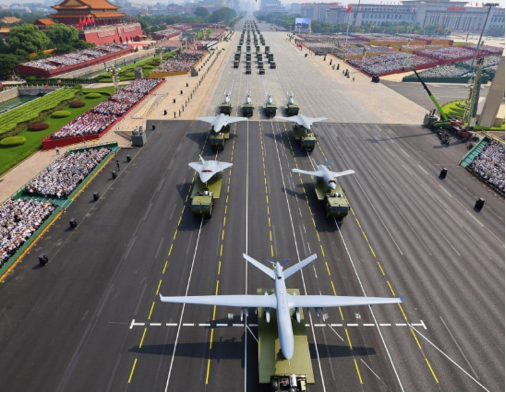By Abubacarr
Copyright standard

China’s Victory Day military parade presents a fascinating paradox. With over 12,000 troops reportedly marching through Tiananmen Square, this spectacle celebrates a defensive military doctrine while showcasing power-projection capabilities that would make any expeditionary force envious. It reveals how Beijing is pioneering a new grammar of military power that particularly resonates with the Global South.The parade’s most consequential audience may not be Washington but middle powers from Jakarta to Johannesburg, governments that are grappling with how to develop military capabilities for an interconnected world while avoiding Cold War entanglements.The parade’s choreographed display of “active defence” – featuring carrier-based aircraft and intercontinental missiles – offers these nations a template for strategic ambiguity. For countries like Indonesia protecting archipelagic waters or Nigeria securing offshore platforms, China’s model suggests they need not choose between capability and non-alignment.The presence of Russian President Vladimir Putin and North Korean leader Kim Jong-un alongside President Xi Jinping deserves scrutiny. This wasn’t merely symbolic solidarity – it was strategic theatre. For Putin, attending while his forces struggle in Ukraine shows that Western isolation has failed. His prominence at the parade validates China’s alternative international order, where pragmatic partnerships trump values-based alliances.Kim’s attendance marks his first multilateral international appearance since the Covid-19 pandemic, a carefully orchestrated return to the world stage. For North Korea, the parade offers legitimacy without denuclearising. Kim’s presence signals to other isolated regimes that China provides diplomatic lifelines outside Western-dominated frameworks. The overall message is unmistakable: alignment with Beijing offers rehabilitation without reform.This trilateral display, with Xi flanked by Putin and Kim, projects an image that serves multiple purposes. It reassures domestic audiences that China isn’t isolated despite Western pressure, shows Global South nations that alternatives to Western partnerships exist and signals to Washington that its sanctions regime has limits. The optics suggest not an axis of evil but an axis of the excluded – nations rejecting Western terms of engagement.As China’s first Victory Day parade since 2015, with 26 foreign leaders attending, the timing is significant. Domestically, the massive display, with an estimated cost of around US$5 billion, represents an implicit bargain: economic opportunities may be constrained, but national dignity is non-negotiable.The emphasis on indigenous innovation sends a message about technological self-reliance amid Western semiconductor restrictions. Each domestically produced system becomes an argument that China can innovate around containment, which is crucial for maintaining confidence as external pressures mount.Yet this messaging contains tensions. Despite efforts to transform political loyalty into combat capability, technical competence matters more than ideological fervour. The parade showcases hardware but cannot display the kind of joint operations capability and combat experience that determine effectiveness.Nonetheless, the parade shows that China’s “great changes unseen in a century” aren’t just about power shifting eastward, but about military power’s grammar evolving. Where traditional powers built expeditionary capabilities for projection, China cultivates such capabilities under a defensive rubric – carriers to protect trade routes, soldiers to evacuate civilians and missiles to deter intervention.The Fujian carrier group is an example of this. For Washington, it represents a worrying projection. For Beijing, it ensures economic lifelines remain open. For Global South observers, it suggests that building strength need not require accepting distinctions between defensive and offensive capabilities.Russia’s participation underscores this. Despite its attacks on Ukraine, Russia frames its actions as defensive against Nato, a logic China’s parade implicitly endorses. This mutual validation of expansive defensive concepts suits both powers, allowing them to justify military build-ups and operations while maintaining defensive rhetoric.North Korea’s nuclear programme also finds implicit acceptance in China’s broad interpretation of legitimate defence. The parade suggests that sovereignty trumps non-proliferation concerns, a message that resonates with nations considering their own nuclear options.The showcased systems, from drone swarms to quantum communications, represent genuine achievement. Yet their rapid development raises questions about testing and operational reliability that parades cannot answer. Showing off advanced combat technology suggests an attempt to compress traditional military development cycles, offering nations hope to leapfrog such timelines, despite the risk of conflating demonstration with capability.For African nations, China’s model offers lessons that military modernisation need not follow Western professionalisation patterns, that political control and combat effectiveness aren’t necessarily incompatible and that defensive doctrines can accommodate power-projection capabilities.The central insight isn’t that China disguises offensive intentions as defensive doctrine, but that this distinction lacks meaning in contemporary competition. When supply chains span oceans and economies depend on distant resources, where does defence end and projection begin?The parade on September 3 didn’t resolve this ambiguity; it celebrated it. For China’s leadership, ambiguity provides flexibility while avoiding security dilemmas. For domestic audiences, it reconciles peaceful development with military strength. For international observers, particularly across the Global South, it offers a model for building capability without accepting binary choices.As the People’s Liberation Army approaches its 2027 centennial, the parade reveals China’s military evolution isn’t about matching American capabilities but rewriting the rules by which military power is understood, justified and employed. These changes may prove more consequential than any weapons on display, altering how nations, from Bangladesh to Brazil, conceptualise military development in an era where traditional categories no longer suffice.The parade was not just a display of might, but a manifesto for a new strategic lexicon, in which “defensive” carriers sail global waters and authoritarian solidarity challenges the liberal international order.



